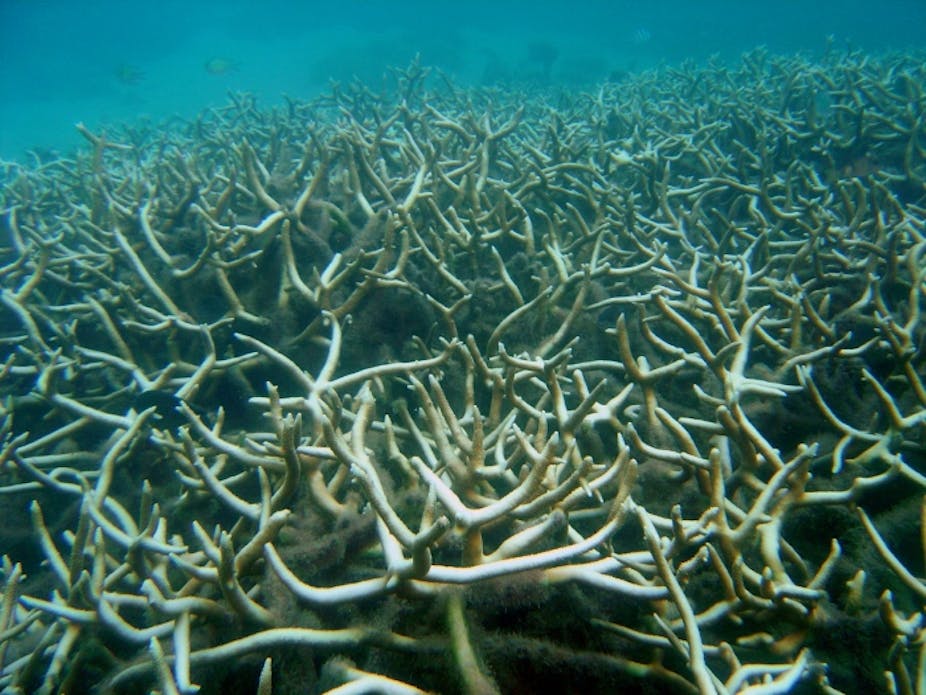As a scientist working on the impact of climate change on marine ecosystems, one of my duties is to communicate my work. My main goal is to convince students, citizens, economists and politicians that we need to take urgent action to reduce our carbon dioxide emissions. This is not an easy task and I often face very difficult questions. Are we really warming the planet? Is there really a link to our carbon dioxide emissions?
I am not a climate scientist and I do not have the expertise to judge the quality of the science behind global warming. But while I’m not a chemist either, I can understand that if carbon dioxide (CO2) is dissolved in water (H2O), it turns into carbonic acid (H2CO3). This is such a simple relationship that there is no place for controversy.
The amount of carbon dioxide released into the atmosphere by human activities is so large that it is changing the whole ocean. Every year, humans are releasing nine petagrams (1015) of carbon in the atmosphere and a quarter of these nine billion tons are absorbed by the ocean. This carbon dioxide turns into carbonic acid which makes the ocean more acidic, a phenomenon known as ocean acidification.
Since the beginning of the industrial revolution, the average surface ocean acidity has increased by 30% and it is predicted that acidity may double again by the end of this century.
This is not without consequences for marine species and ecosystems. Many laboratories around the world have demonstrated that if we do not drastically cut carbon dioxide emissions, many species and ecosystems potentially face extinction within decades. For example, the brittlestar Ophiothrix fragilis - a close relative to starfish - is a key species on the west coast of Europe. It is not unusual to find hundreds of individuals per square metre and these beds of brittlestars constitute a habitat for dozens of other species. When we raised Ophiothrix larvae in ocean conditions that could be expected within a few decades, we found they were unable to develop normally and all died within a few days. Perhaps you may not care if this brittlestar goes extinct - but if it does it will have a huge impact on the many species associated with it, including fish.

Ocean acidification is not something that will happen in a distant future. We can monitor chemical changes and the first biological signs are already visible today - some massive oyster declines on the west coast of the USA have been attributed to ocean acidification, as has been linked to coral bleaching.
Of course many uncertainties remain. More information is needed if we want to fully understand the impact of ocean acidification on the oceans, as advocated in a piece that we published in the scientific journal Nature today. Today, we know that to capture the potential impacts of ocean acidification on marine ecosystems, we need to perform longer term experiments, and expand from studying single species to whole ecosystems to capture the environment’s complexity. Ocean acidification is happening together with other global changes such as warming, deoxygenation and freshning (de-salination from mixing with fresh glacial meltwater). On top of this, you have local pressures on ecosystems, such as pollution or over-fishing.

However, uncertainty is not an excuse for inaction. We do know enough to claim that ocean acidification may lead to major changes in marine ecosystems, including reduction in biodiversity and impacts on seafood and other ecosystem services.
So what can we do? The obvious answer is that we need to reduce our carbon dioxide emissions. There is no other serious alternative at the moment. We know that this may be a long and difficult process, so we need to buy some time.
This can be achieved in various ways. We can reduce other pressures such as pollution or over-fishing on a marine ecosystem suffering acidification so as to improve its ability to help itself, increasing its resilience to other factors. We can also make use of the oceans’ diversity to select some strains of important species, for example those important to food fisheries, that are more tolerant of environmental changes. Some species of oysters, for example, have been shown to be less sensitive to ocean acidification than others .
Ocean acidification is chemistry, not conjecture - it is as real as water making you wet. It is one of the major threats on the marine realm, and it is essential to act now and reduce carbon dioxide emissions if we are to keep a diverse and productive ocean.

